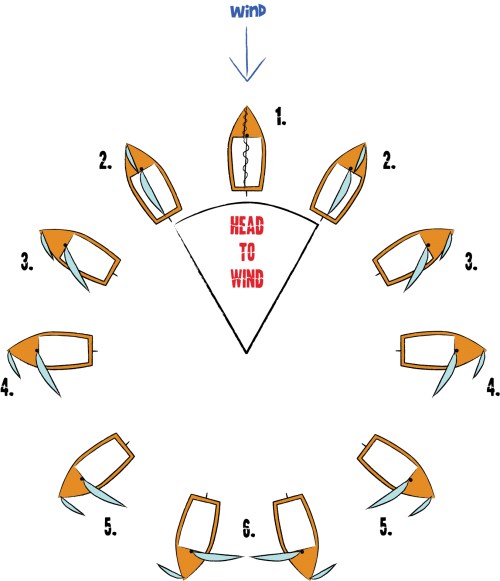Points of Sail
Go To: Sailing - Learn To Sail
Posted on 30 November 2007 14:53
Wondering why you can't sail directly upwind? Find out why.
Depending on which direction you are sailing compared to the direction of the wind, your sails will need to be in different positions on the boat. These are called points of sail, and in combination with Centreboard Settings, control how you can sail. Check our diagram below, with our guide on how your sails should be set for each point of sail.

Diagram 1: Points of Sail
1. Head to Wind
Also known as in irons, or the no-go zone, there is a 45 degree wide band around directly upwind into which a boat cannot sail. When you're in this zone, your sails will flap, and you will not sail anywhere fast!
2. Close Hauled
This is the point of sail when the boat is headed as close to the wind as it can while still maintaining power in the sails. This is typically 45 degrees off the wind.
When a boat is heading just to either side of the no go zone it is considered to be close hauled. When a boat is close hauled the sails should be trimmed in tight. The dagger board should be all the way down. On this point of sail, the boat exclusively through lift generated by the sails, much like an airplane wing.
3. Close Reach
Halfway between close hauled and a beam reach, sailing on a close reach is a comfortable point to sail to be in, with plenty of options either way. The sails should be trimmed in slightly less than when close hauled, and the centreboard or daggerboard should be three quarters down.
4. Beam Reach
The point of sail where a boat is headed 90 degrees off the wind, or directly across it. When a boat is on a beam reach, the wind is blowing across the side, or beam, of the boat, hence the name beam reach. When one is on a beam reach, the sails should be trimmed about halfway. The dagger board can be raised about halfway. On this point of sail, the boat is still mostly using the lift principle to move. On many boats, the beam reach is the fastest point of sail.
5. Broad Reach
When a boat is headed so that the wind is hitting the boat on one of its back corners.
On a beam reach, a boat should have its sails about ¾ of the way out. The dagger board can have about a 1/3 of its surface in the water. On this point of sail, a combination of lift, as well as the pushing force of the wind is moving the boat.
6. Run
There are two slightly variations on the run. On a training run, the boat is aimed 5-10 degrees off of a true run (directly downwind); this is much safer, because you are less likely to gybe. The sails are eased out as far as they can be, and the centreboard is only slightly down.
On a dead run, you are sailing directly downwind; the main sail can be on either port tack or starboard tack, and in a two-sail boat, the jib is typically goosewinged (set on the opposite side to the main sail), for more useable sail area (when not goosewinged the jib is blanketed by the main) and increased speed.
On a run is also the typical point of sail at which to use a spinnaker, although assymmetrical spinnakers should be used on a beam or broad reach.